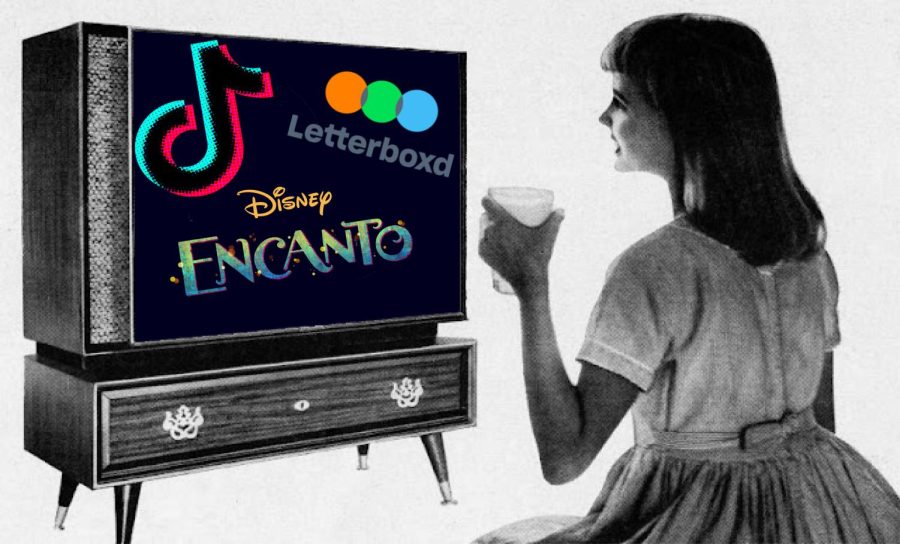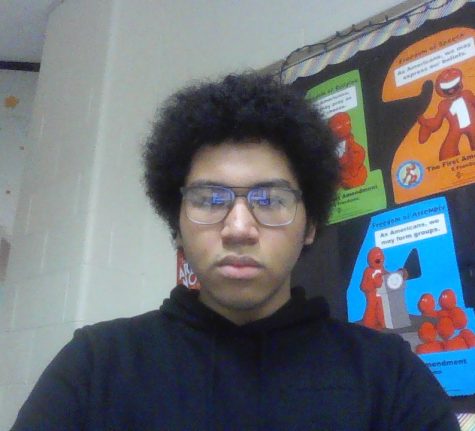We Don’t Talk About ‘Encanto:’ How White Inclusion Becomes White Intrusion
Opinion
Everyone likes to feel included in a new trend, but we must recognize that when this inclusion is at the expense of the trend’s original community, it becomes intrusion.
April 22, 2022
A few months back, the Mitski song “Your best American girl” was part of a trend on TikTok. In it, she sings about her struggles as a woman of color, particularly her experience existing outside of the conventional, eurocentric beauty standards. In its early stages, the trend was full of people who felt excluded from conversations about beauty due to “ethnic” features such as certain hair types or certain nose shapes. But as the trend drew more people, it began to shift. White people began to take over the trend, talking about how many of them felt outside mainstream beauty standards due to details like being brunette when many prefer blonde. Ignoring the fact hair can be dyed and skin can’t, this is representative of what happens to many of the things that people of color create.
The most prominent example of this is when white people attempt to use African American vernacular English (more commonly known as AAVE). Without the knowledge of the dialect, many white people simply see AAVE as “cool internet slang.” They attempt to use it, and in doing so, butcher it. In worst-case scenarios though, there is far more harm to be done, both intentionally and unintentionally. Instead of some very badly integrated phrases, this use of AAVE evolves into something else entirely. Exaggerated speaking, a different cadence, the body language used, the rise and fall of a sentence.
By the time they’re done with it, it’s not bad AAVE usage, it’s a blaccent. Whether from New York or Oklahoma, no matter where they’re from, all blaccents sound the same when spoken. And unlike actually AAVE usage, a blaccent is new age minstrelsy: a caricature of black people meant for consumption by primary non-black audiences. When a white person needs to appear “cool” or “hip” or tougher than they are, a blaccent never fails to come to mind.
Similar to what happened to jazz music in the ’20s and rock and roll in the ’60s, white people find something associated with blackness and attempt to adopt it, seeing the novelty as a way to be “edgy.” This adoption is appropriation. And when it served its purpose and they’ve gained enough clout, they abandon it. If they use it too long, the novelty wears off, and the person becomes too closely associated with blackness. Such an association could negatively impact their career or worse, they’d be expected to speak on black issues. A lá Miley Cirus circa the mid-2010s. Or any child star trying to break from Disney’s orbit, for that matter.
What both of these trends have in common is the conditional participation of white people. This isn’t the first time something like this has happened and it’s existed long before TikTok. Some people will remember vines in which members of a certain racial group would make jokes about their own community. But invariably white people could often be found joining in the post’s comment sections. TikTok however, has increased the scale multiple times over. Not only is it happening on a larger scale, but it is expanding beyond race. Now it not only encompasses race but ethnicity, nationality, and even sexuality.
Most recently, this pattern has reared its head with the TikTok discourse surrounding the Disney movie “Encanto.” The movie focuses on the experiences of latine people, specifically how trauma becomes generational. Trauma which many latine people have had to endure, as the story reflects the real displacement of indigenous Colombians by anti-government guerrillas. After being forced to leave her home, the family matriarch, Alma Madrigal establishes a new town in which she and her offspring gain magical powers. However, because Alma doesn’t deal with the memories that she either represses or diminishes, the hardships that she endured become the basis for a family in which the expectations are stringent, and failure to meet those expectations results in ostracization. Any deviations from what is expected will result in expulsion.
But many white people, lacking the cultural and historical context, overstep in their analysis, misunderstanding the movie’s themes. Others, however, felt a sense of unearned familiarity and were simply offensive. Take for example a TikTok in which a white TikToker makes jokes about Alma and the trauma she endured. In the film, when Bruno threatens to leave the household, Alma responds, “if you leave you are dead to me.” This Tiktoker’s response to this was to say, “the only person who’s dead, is your husband.” Her husband was murdered in front of her and her infant children. To have someone so callously make jokes that would be considered distasteful even if a Columbian made them is a reminder that many white people will become too comfortable making jokes that aren’t theirs to make.
It goes deeper than race. Many queer people have been “headcanoning” certain characters as being queer in some capacity. Headcanons were initially a way for queer people to gain representation where there was none. Most often, it was done when there was supposed “queer baiting,” a term that refers to when show-writers imply a queer relationship but never officially confirm it, therefore benefitting from the “representation” without actually representing anything.
This manifests in “Encanto” discourse in two ways. The first is that many people are headcanoning Luisa as a trans woman. Her power is that of super strength. While the reading of a masculine female character as trans is already problematic, it crosses into the territory of white supremacy when it is a woman of color, as women of color have historically been stereotyped as “stronger” to the point of being masculine. Doctors would ignore their pain or think that they feel less than their white counterparts. When gender and race intersect, any non-white woman is viewed as inherently less feminine.
And it doesn’t stop at women. Men of color are also affected. There has long been a hyper-sexualization of men of color. Any man who doesn’t fit into that is viewed as effeminate. When MOC express themselves in traditionally non-masculine ways, they are more likely to be viewed as feminine than their white counterparts are. This is clear in the way that white queer people read the character of Bruno. Because he is shy and doesn’t fit into the typical masculine role, they see him as a trans man. Queer white people are more accepting of fictional characters than actual people of color in their communities, and it is shown very clearly here.
In seeking representation, many queer people are overlooking the latine representation in “Encanto.” They could not relate, so they actively remove the aspects of the race and culture from it to feel included. And it’s not like people haven’t been telling them. Go to any Letterboxd review in which the reviewer reads the characters as gay, and you will find more deleted responses from people arguing than people agreeing. After a certain point, it stops being about being ignorant of the problem and becomes actively ignoring the problem. Representation in the media is a complicated issue to solve, but trying to solve it without any consideration for intersectionality will only make things worse.
Spaces, media, and jokes not meant for white people have typically been created in response to people of color’s exclusion from the mainstream. And while it is perfectly acceptable for white people to be included in these spaces, that inclusion is up to the discretion of the people in the community, not those outside it.





Michele Gallagher • Apr 26, 2022 at 1:06 pm
Thank you for this extremely well-written and insightful article. You handle this important and complex topic thoughtfully and your writing is so effective. The Wingspan is lucky to have you, but this article would be at home in any professional publication. Your future is bright, and we are glad your voice is being heard!
Phil Daniels • Apr 24, 2022 at 8:48 am
Josue – Just “wow”. Really impressive article and well done. You had me at “blaccent is new age minstrelsy” and you made it all way to intersectionality. These are tough and complicated topics but you made it accessible. Thank you for this.
Miss Boyle • Apr 22, 2022 at 2:30 pm
Great article, Josue. Great writing.
Jhonny C • Apr 22, 2022 at 1:43 pm
Thanks for this article. Great work.
Catherine Schunder • Apr 22, 2022 at 12:17 pm
A very well written and thought-provoking article indeed. First year on Wingspan…what can we expect next year?!
Rachel Brewster • Apr 22, 2022 at 11:18 am
Josue this is beautifully written and very thought provoking. Thank you for sharing your perspective and analysis. I hope that others are able to process and reflect on how they fit into this equation. Keep being you and making the world a better place!
Jenn Thompson • Apr 22, 2022 at 10:11 am
The writing in this article is extremely impressive – such a gift! I also appreciate bringing awareness to this topic. It will certainly encourage reflection and conversation. I look forward to your next article!
M. Loebig • Apr 22, 2022 at 9:32 am
This is 100% the best article Wingspan has ever published. The topic is informative, educational, and engaging. But the WRITING is phenomenal: syntax, diction, voice… Josue Guinto-Veronica is a mental giant. The world better watch out for this student!!!
Mr. Cumberland • Apr 22, 2022 at 9:23 am
Outstanding work discussing peoples’ reaction towards the movie over the movie itself. This article has given me a bit to think about!